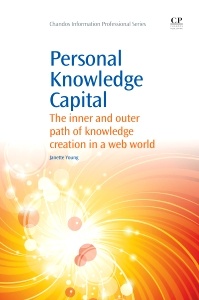Description
Personal Knowledge Capital
The Inner and Outer Path of Knowledge Creation in a Web World
Chandos Information Professional Series
Language: English
Subjects for Personal Knowledge Capital:
210 p. · 15.5x23.2 cm · Paperback
Description
/li>Contents
/li>Biography
/li>Comment
/li>
Dedication
List of figures and tables
Acknowledgements
Preface
About the author
Part 1: The inner path of knowledge creation
Chapter 1: Introduction to personal knowledge capital
Abstract:
Knowledge management and knowledge creation
The knowledge worker
Knowledge management in a web environment
Personal knowledge management
Introduction to personal knowledge capital
Summary
Introduction
Chapter 2: Exploring knowledge creation tacit knowledge
Abstract:
Knowledge creation and SECI
Summary
Chapter 3: Tuning-in: knowingness for inner personal knowledge capital
Abstract:
Living and sensing
The inner realm
Tuning into feelings and heart
Zen: quiet time for creativity (the tools for personal knowledge)
Summary
Reflective exercises
Chapter 4: Mastering self and behaviour
Abstract:
The power of thought
Pruning the garden of your mind
The emotional wheel
Think, feel and behave
Summary
Reflective self-assessment questions
Chapter 5: Ka, the knowledge awareness model for knowledge creation
Abstract:
Developing knowingness
Ka: the knowledge awareness model of knowledge creation
‘Ka’, the knowledge awareness model of knowledge creation incorporates the LOFT
Summary
Reflective exercises
Part 2: The outer path of personal knowledge capital in a web environment
Introduction
Chapter 6: Personal knowledge and network building
Abstract:
Good relationships and caring environments
Shadow knowledge
Valuing personal knowledge
Reflective practice (business practice tools)
Summary
Exercises for self-assessment
Chapter 7: Social capital and trust for a web environment
Abstract:
Intellectual capital
Social capital
Social capital and the virtual environment
Relationships and trust
Trust, conversation and learning in the online environment
Summary
Exercises
Chapter 8: The magic box
Abstract:
Ideas
Conversation
Knowledge, blogs and social interaction
Summary
Exercises
Chapter 9: Community and culture
Abstract:
Community, trust and social capital
Types of web-based community
Communities of practice
The e-learning community
The wisdom community
The knowledge community
The network community
Culture
Assessing organisational cultural readiness for knowledge sharing
Summary
Reflective exercises
Chapter 10: Mobilising and designing the web infrastructure for twenty-first-century living
Abstract:
Knowledge-based systems and value added
Knowledge and interactivity online
The infrastructure and ecology for knowledge-based systems (IEKBS)
Pruning the garden
Summary
Reflective exercises
Chapter 11: The application and exploration of knowledge creation theory
Abstract:
The Unified Model of Knowledge Creation
The SECI model
The changing nature of the Ba metaphor
‘Ba’, changing labels, and virtual interaction
Valuing Knowledge Creation Assets (KCAs)
The application of Knowledge Creation Assets in virtual space
The management of the knowledge creation theory
Managing the virtual environment
Summary
Reflective exercises
Chapter 12: The Knowledge Cube: a model for knowledge creation in the web environment
Abstract:
The Knowledge Cube processes
Summary
Conclusion: the inner and outer path of knowledge creation
Inner personal knowledge capital
The outer path of personal knowledge capital
Balancing, valuing and exploiting your personal knowledge capital
Summary
Glossary
References
Index
- Examines know-how, tacit knowledge, and emotional and cognitive knowledge
- Links social capital to web technologies to create innovative frameworks, tools and models
- Puts forward tools and mechanisms supported by research, which can be used for the design of a knowledge infrastructure
These books may interest you

World Englishes and Culture Wars 123.79 €

World Englishes and Culture Wars 35.19 €


